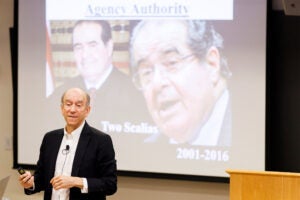TV races toward its future
Industry exec shows how it’s evolving into on-demand experience
Anne Sweeney, Ed.M. ’80, remembered being a 20-year-old page at ABC TV during the 1970s — a wide-eyed novice in a gray skirt who had to keep silent and still until the commercial breaks.
Sweeney is still wide-eyed, but is no longer silent and still. One of the most powerful executives in television as co-chairman of Disney Media Networks and president of Disney/ABC Television Group, Sweeney led off this season’s series of Askwith Forums at the Harvard Graduate School of Education (HGSE) Monday night (Sept. 20).
Her message was that television is no longer standing still either, as when it was just “a box in your living room.” Instead, television now is a dynamic platform that shows how quickly technology is moving in the digital age, how the viewer experience is changing, and how creativity is still the bedrock of the entertainment machine.
“As I was sitting so still,” said Sweeney of her early fascination with television, “the medium never stopped moving.”
As if to illustrate this constant motion, she punctuated the discussion with video clips for the packed crowd at Longfellow Hall. The first was a loud, rapid-fire kaleidoscope of Disney television products, from sitcoms and dramas to movies and sporting events. Sweeney called the clip “a portfolio of our businesses,” screen products meant to appeal to audiences “from the age of 2 to their grandparents.”
Sweeney is a master of the “tweens” target audience, said HGSE Dean Kathleen McCartney, the age 9 to 14 demographic that not only drives innovation, but expects and demands it. The guest from Disney, said McCartney in her introduction, “has led the [television] industry into the digital age.”
Sweeney acknowledged the importance of the 9 to 14 demographic, an age group she said “has driven so much innovation” already. She set aside a recent Saturday to puzzle out a new plug-in feature on her home television, but her pre-teen children had beaten her to it by a week.
“Think of them as digital natives,” she said of the millennial generation born between 1980 and 2000, the largest since the Baby Boom and a generation that is casually adroit with the tools of digital access.
One earlier Disney campaign encouraged kids to “tune in and log on,” said Sweeney, who recognized early on that television could have a multiplier effect, leading viewers from the TV screen to the computer screen and back again. That was important, in part, she said, because research showed that viewers missed 80 percent of any television show’s episodes, prompting ABC to become the first company to put its shows online.
ABC’s “Wildfire,” a series that premiered in 2005, was the first to be accompanied by what Sweeney called “a viewing party,” an online community that could watch the show and comment on it simultaneously.
Then it was “Hello, Facebook; goodbye, viewing party,” she said, one in a line of rapid social-networking changes that characterize how viewership has evolved.
Then came the iPod, a technology that “changed our business forever,” said Sweeney. “We decided to be the first to put TV content on iTunes.” The speedy process took an unheard-of three days, she said, and spurred “a crazy burst of creativity in our technical team.”
With the iPod arrived, television was no longer that box in the living room, said Sweeney, but a flexible “content studio” that allowed viewer comments.
The series “Lost” has spawned 40 main fan sites on the Internet, she said, and 25 dedicated Facebook pages. Interactivity like that allows viewers “to keep discovering the show,” said Sweeney. “Lost,” with its narrative complexity, was “the perfect poster show … for digital platforms.”
The iPod and other technologies keep jarring the digital age into new shapes, “turbo-charging the medium,” said Sweeney. “It could take an entire semester to do this subject justice.”
How you watch television continues to change, she said, as viewers undergo a temporal shift in attitudes. They now expect to watch content whenever they want.
Viewers now even expect content to travel with them wherever they go. “The newest way to watch television is on an iPad,” said Sweeney. The iPad also prompted rapid response within the industry, she said. ABC built and loaded its iPad app in just five weeks.
Sweeney pushed the button on another video clip, a look at the new ABC News iPad app that allows viewers to “spin the globe” and customize news programming. “We keep expanding options for viewers,” she said. “It’s all about customizing the world to your life. The future of television is very personal.”
About 8.5 million episodes of ABC shows have already been downloaded.
All this is very good news for the industry, “as long as we can create content [viewers] want to watch,” said Sweeney.
While technology speeds up, and television platforms multiply, a questioner asked later, is that vaunted child demographic in danger of being overwhelmed, or even “addicted”?
“This is one of those moments when we desperately need parents in the equation,” said Sweeney, whose television group offers children’s programming 24 hours a day. “The technology isn’t going to stop.”




